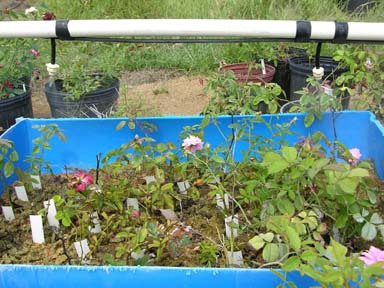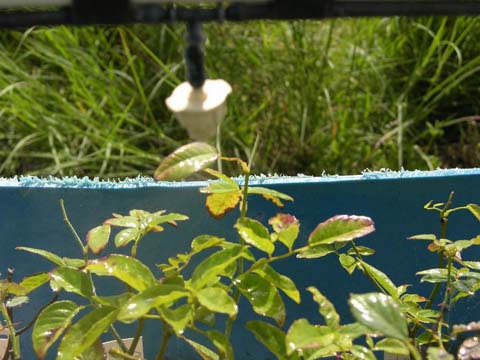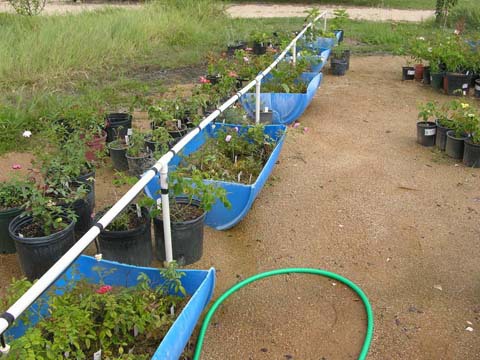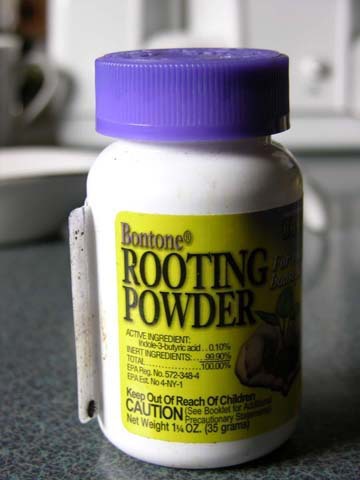
Propagation by cuttings:
September has cooled off and it rained! Now comes fall, the most pleasant gardening season of Texas, I think. This is a great time to propagate cuttings. Taking cuttings is an effective, cheap way to propagate many woody plants such as trees, shrubs, and roses. Not all will propagate easily, but I have had great luck propagating cuttings of most rose, crepe myrtle, esperanza, Centrum, and Althea shrubs. Trees such as sycamore and cottonwood trees that like water are also easy to propagate by cuttings. Any plant with a woody stem might be propagated through cuttings, but some grow roots easier than others, usually depending upon how susceptible they are to rotting funguses.
Many people who visit Hummingbird Hill are interested in my cutting propagation method. My friends who are also Taylor's local rose breeders, Ray Ponton and Robert Stiba, taught me a simple and effective method of doing this by using sand and misters. This method works best in full, all day sun because the cuttings need a long daylight period to make enough energy to grow roots. You can put the sand directly on the ground, in some sort of raised bed, or in plastic boxes, but in all cases the sand needs to be at least 5 inches deep or more, depending upon how large the cuttings grow before you transplant them into pots. The secret of sand is that it must drain quickly, or the cuttings are likely to rot. Therefore, use coarse construction sand, and not the play sand that you buy to fill children's sandboxes. If you use tubs to put your sand in, be sure there are lots of drainage holes, and that the tubs are elevated several inches above the ground.
September has cooled off and it rained! Now comes fall, the most pleasant gardening season of Texas, I think. This is a great time to propagate cuttings. Taking cuttings is an effective, cheap way to propagate many woody plants such as trees, shrubs, and roses. Not all will propagate easily, but I have had great luck propagating cuttings of most rose, crepe myrtle, esperanza, Centrum, and Althea shrubs. Trees such as sycamore and cottonwood trees that like water are also easy to propagate by cuttings. Any plant with a woody stem might be propagated through cuttings, but some grow roots easier than others, usually depending upon how susceptible they are to rotting funguses.
Many people who visit Hummingbird Hill are interested in my cutting propagation method. My friends who are also Taylor's local rose breeders, Ray Ponton and Robert Stiba, taught me a simple and effective method of doing this by using sand and misters. This method works best in full, all day sun because the cuttings need a long daylight period to make enough energy to grow roots. You can put the sand directly on the ground, in some sort of raised bed, or in plastic boxes, but in all cases the sand needs to be at least 5 inches deep or more, depending upon how large the cuttings grow before you transplant them into pots. The secret of sand is that it must drain quickly, or the cuttings are likely to rot. Therefore, use coarse construction sand, and not the play sand that you buy to fill children's sandboxes. If you use tubs to put your sand in, be sure there are lots of drainage holes, and that the tubs are elevated several inches above the ground.
The use of misters are two-fold. They gently water the plants by misting the leaves, and they keep the plants cooler. The misters are turned on in the morning and off at night. Each mister uses 1/2 gallon of water per hour. The misters are nothing special. You can even use pet misters from hardware stores. They are available everywhere. I buy mine at Home Depot. You need to place the misters high enough above the sand to water the leaves of all the cuttings in your sand box, but close enough where the wind won't completely blow the mist away without watering your plants. My husband, Jerry, used surplus plastic water pipe and pieces of rebar as the frame to hold up the misters and the tiny water line they were connected upon. He taped the mister waterlines to the 1/2 inch plastic water pipes. Rebar was put inside of the water pipe "legs" and pushed into the ground to support the structure. Anything that holds the mister's waterlines above the boxes at the correct height will do, though.
Jerry made my tubs out of commercial laundry detergent tubs cut in half, and drilled 1/2 holes in the bottoms for drainage. I put copper screen pieces over the holes to keep in the sand, and set the tubs upon bricks. It looks like they are setting on the ground because I had to put sand around them to walk upon. When the dirt got saturated it stayed too muddy to work there easily.
Make your cuttings about 6 inches long. If they are too long, it is difficult for the plants to take up enough water. If they are too short, then there won't be enough leaves to make food for the plant to grow roots. Once you take your cuttings, it is best to immediately get them in the sand. If you can't do this, then keep them cool until you can, such as in an ice cooler, or in the refrigerator crisper drawer. If you don't propagate them immediately, the plants will quickly seal over at the cut, so just before you put the cuttings in the sand, cut them again. One branch can be cut several times to make several cuttings. Cuttings can even be sent in the mail, and traded with people if the weather is cool enough. If they dry out, though, cuttings are useless.
Before you place your cuttings in the sand boxes, rough up about an inch of cambium (the green growing layer beneath the bark) on the stem with a dull knife, and dip this end in hormone rooting powder. This will encourage the plant to root without rotting. Hormone rooting powder is inexpensive and you can get it at most nurseries. The only other thing to do is label the plant cutting and wait for it to root. I like to use pieces of old vinyl venetian blinds as the label, and I write on it with a pencil. The pencil will not fade in sunlight or wash off with water, and the venetian blind labels will last more than one season.
Before you place your cuttings in the sand boxes, rough up about an inch of cambium (the green growing layer beneath the bark) on the stem with a dull knife, and dip this end in hormone rooting powder. This will encourage the plant to root without rotting. Hormone rooting powder is inexpensive and you can get it at most nurseries. The only other thing to do is label the plant cutting and wait for it to root. I like to use pieces of old vinyl venetian blinds as the label, and I write on it with a pencil. The pencil will not fade in sunlight or wash off with water, and the venetian blind labels will last more than one season.
It is surprising how many plants will grow a fist full of roots in 6 to 8 weeks. To check, just dig around them with your hands in the sand and look. You can even dig up the cuttings that have begun to root and move them to a new place in the sand boxes without hurting them. I have rooted plants this way all year around, but summers are really too hot, because it makes the roots more susceptible to rotting, and plants grow roots very slowly during the winter. In the winter, a light frost does not hurt roses, trees, and hardy shrubs as cuttings, but you have to protect them during a very hard cold period that might freeze the stems and roots. This is why I like to root cuttings during the spring and fall when it is easier to have success. Starting cuttings is cheap, easy, and fun. It's a great way to gain many plants, and share them with your friends.
I am not a professional nursery, but you are welcome to come see my misting system. I always have extras for sale, and I will attempt to propagate any of your special plants. There is only a charge if I succeed. I charge $10/ gallon pot. You can mail me your cuttings and I can mail the results back. I accept cash, checks, and Paypal.
I am not a professional nursery, but you are welcome to come see my misting system. I always have extras for sale, and I will attempt to propagate any of your special plants. There is only a charge if I succeed. I charge $10/ gallon pot. You can mail me your cuttings and I can mail the results back. I accept cash, checks, and Paypal.



